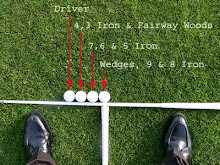A Rules Quiz...Test Your Knowledge of Some Interesting Rules Questions
Practice Swing Accidentally Moves Ball in Play
Q. While making a practice swing, a player accidentally moved the ball in play with the club. What is the ruling?
A. The player incurs a one stroke penalty, and must replace the ball to its original position. If the player fails to replace the ball, a total penalty of loss of hole in match play or two strokes in stroke play will be incurred.
Ball in Play Moved by Wind or Gravity
Q. A player replaces his ball on the putting green and the ball is at rest. Without addressing the ball the player steps away to read his putt.
The ball moves either due to the wind or the slope of the putting green. How should the player proceed?
A. The player must play his ball from the new position without penalty.
If the ball was moved into the hole then the player is deemed to have holed out with his previous stroke (Decision 20-3d/1).
Note: It is not relevant whether the player had removed his ball-marker before the ball was moved by the wind or gravity as the player's ball was in play when it was replaced (Rule 20-4).
Ball Deflected by Player's Equipment
Q. What is the ruling if my ball in motion is accidentally deflected by my equipment?
A. In either form of play (match play or stroke play) the player incurs a one-stroke penalty and must play the ball as it lies.
Stones in Bunkers
Q. What is the status of stones in bunkers?
A. Stones are by definition loose impediments regardless of their location. Thus, when the ball and the stone lie in or touch the same hazard, the stone may not be removed. However, a Committee may adopt a Local Rule stating that stones in bunkers are movable obstructions. Unless this Local Rule is put into effect by the Committee, players may not remove stones in bunkers without penalty.
Ball Lying Against Rake in Bunker
Q. My ball lies against a rake in a bunker, am I entitled to relief?
A. Yes. A bunker rake is a movable obstruction (see Definition of "Obstuctions") which the player may remove in accordance with Rule 24-1.
If the ball is touching the sand in the bunker (or another part of the course) then the rake may be removed in accordance with Rule 24-1a.
If the ball is resting solely on the rake (i.e. not also touching a part of the course) then Rule 24-1b permits the player to lift the ball, remove the rake, and drop the ball as nearly as possible to the spot directly beneath where the ball lay on the rake (but not nearer the hole).
Ball Thought to be Embedded is Lost
Q. I hit my ball right down the middle, I know it`s there, it must have embedded in the soft ground. Am I allowed to drop a ball without penalty where I think it might have come to rest?
A. No. If the ball can not be found, the player must proceed under Rule 27-1, incurring the stroke-and-distance penalty. There is nothing in Rule 25-2 that permits a player to take relief for a ball that is thought to be embedded without identifying it first. The soft mushy earth is not an abnormal ground condition unless casual water is present, in which case Rule 25-1c applies.
Reaching Across Hole to Tap in Short Putt
Q. A player reaches across the hole to tap in a short putt (the hole is between the player and the ball). Is this a breach of Rule 16-1e, Standing Astride or on the Line of Putt?
A. No. The line of putt does not extend beyond the hole. There is no penalty for making a stroke in this manner, provided the ball is fairly struck at and not raked into the hole.
Club Broken During Stroke, Practice Stroke, or Practice Swing
Q. A player breaks the shaft of his 4-iron when the follow-through of his stroke causes the shaft to make contact with the trunk of a tree. May the player replace the club during his round?
A. Yes, the player may replace the club -- see Rule 4-3.
The player's club is unfit for play and this occurred during the normal course of play (see Decision 4-3/1).
The broken club may be replaced provided the player does not unduly delay play and provided he does not replace the club by borrowing a club selected for play by any other person playing on the course.
The player does not need to replace the broken 4-iron with another 4-iron; he may replace it with any conforming club.
Wednesday, April 14, 2010
Subscribe to:
Post Comments (Atom)





No comments:
Post a Comment